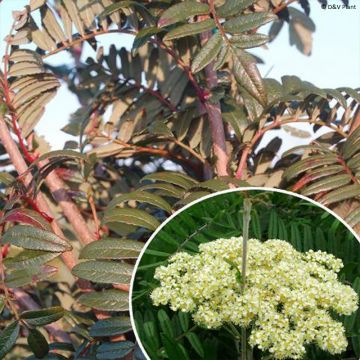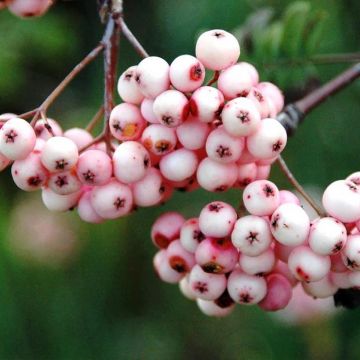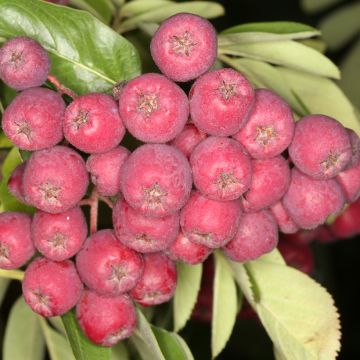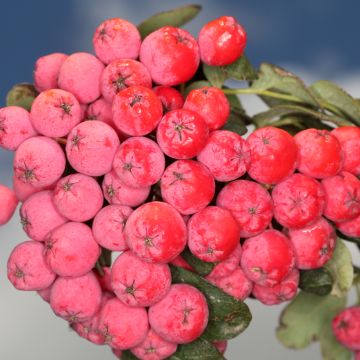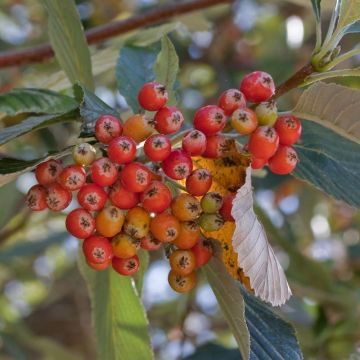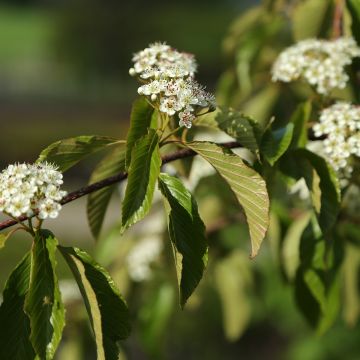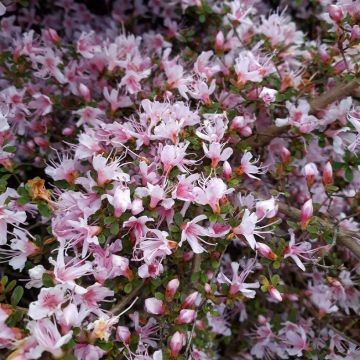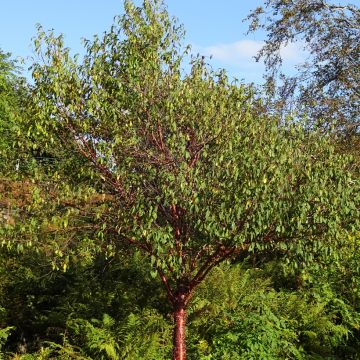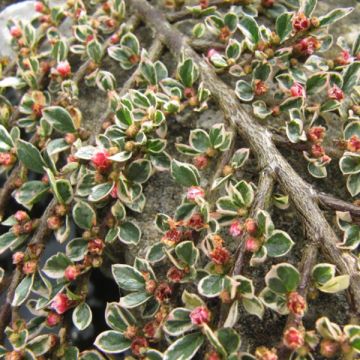

Sorbus Copper Glow - Rowan


Sorbus Copper Glow - Rowan
Sorbus Copper Glow - Rowan
Sorbus x arnoldiana Copper Glow
Rowan, Mountain Ash
Why not try an alternative variety in stock?
View all →This plant carries a 24 months recovery warranty
More information
We guarantee the quality of our plants for a full growing cycle, and will replace at our expense any plant that fails to recover under normal climatic and planting conditions.
Oversize package: home delivery by special carrier from €6.90 per order..
Express home delivery from €8.90.
Does this plant fit my garden?
Set up your Plantfit profile →
Description
Sorbus 'Copper Glow' is a charming small tree with a well-proportioned conical habit, twice as tall as it is wide. Its deciduous foliage, composed of numerous green leaflets, is elegant and ornamental. In spring, it produces corymbs of cream-white flowers that contrast beautifully against the darker vegetation. After fertilisation, the flowers develop into small decorative berries, a lovely copper-orange, which delight birds in autumn. At this time of year, the foliage turns red, providing a beautiful display in the garden. Able to adapt to most well-drained soils, very resistant to cold as well as urban pollution, this Rowan will find its place both in a small city garden and in more rural areas, in a space that is more natural than formal.
Sorbus, which includes the Rowans with compound leaves and the Service trees with simple leaves, are part of the very large family of Rosaceae. This family includes both wild species from the countryside (woodland strawberry...) and numerous ornamental plants (Amelanchier, Lady's Mantle, Rose...) as well as most of our temperate and Mediterranean fruit trees (Apple trees, Apricot trees...). Sorbus x arnoldiana is a hybrid resulting from the cross-breeding between Sorbus aucuparia (the famous Rowan) and Sorbus discolor, native to northern China where it can reach heights of up to 10 m. It was described in 1920 by the great American botanist Alfred Rehder, whose plant identification work is still referenced today. This hybrid is very close to the Rowan, differing by slightly smaller leaves and more or less hairless winter buds.
'Copper Glow' is a cultivar of small to medium size, which typically forms a small, conical, and slender tree, with a trunk that is often quite straight, reaching 8 m in height (sometimes 10) and 4 m in width. The branches bear odd-pinnate leaves, meaning composed of an odd number of leaflets, ranging from 9 to 17. These have a very elongated lanceolate shape, toothed along their edges, and are medium to dark green. They are arranged oppositely on either side of the leaf rachis, with a leaflet terminating at the end of it. They are very ornamental with their fern-like appearance.
Around May, approximately 10 cm diameter corymbs form, composed of tiny cream-white, single flowers, with stamens protruding from the corolla, giving them a fluffy appearance. These inflorescences are homey-producing, thus adding a useful appeal to wildlife in addition to the ornamental character of the plant. Once fertilised, the flowers gradually develop into spherical fruits, approximately 1 cm in diameter, and of an original copper-orange which gave its name to the variety (Copper Glow = copper glow or shine). Ripening in September, these berries are a feast for birds. Autumn offers yet another opportunity for this Rowan to shine as its foliage then ignites in red before finally falling to the ground.
The 'Copper Glow' Rowan is an extremely hardy (-30°C) and easy-to-cultivate plant, and its dimensions allow it to be planted even in small city gardens. Its natural appearance will fit equally well in a rural environment, where you can plant it alongside other wilder looking plants. A beautiful specimen of Hawthorn (Crataegus) with generous flowering will be a perfect companion to the rustic silhouette. To create a striking autumn contrast, plant a small Amelanchier alnifolia 'Martin', or Alder-leaved Amelanchier, whose slightly bluish-green foliage will turn yellow at the end of the season. In spring, this small bush will offer you superb white flowering, which will later fruit in the form of sweet berries resembling blueberries. To stay within the Rosaceae family, add a specimen of Rosa glauca, a botanical rose with foliage ranging from purple to bluish, and whose small pink flowers, with white petals at the base and a golden centre, will captivate you. They are honey-bearing and develop shiny red fruits that remain on the plant throughout winter, nourishing the birds.
Report an error about the product description
Sorbus Copper Glow - Rowan in pictures


Plant habit
Flowering
Foliage
Botanical data
Sorbus
x arnoldiana
Copper Glow
Rosaceae
Rowan, Mountain Ash
Cultivar or hybrid
Other Sorbus - Mountain Ash
Planting and care
Sorbus 'Copper Glow' thrives in sunlight and also develops well in partial shade. It is a tree that does not favour strong light and high temperatures. Position it sheltered from prevailing winds to avoid uprooting. It appreciates rich, moist soil but requires a well-drained location that is not too wet. It grows well in loamy-sandy soil or clayey-sandy soil, either dry or slightly moist, preferably with an acidic or neutral pH, also accepting slightly alkaline soils without too much active lime. Once well established, it tolerates short periods of drought quite well. Water it during very dry spells, especially during the first few years. Well-suited to urban pollution, it is a good choice for city gardens.
Planting period
Intended location
Care
This item has not been reviewed yet - be the first to leave a review about it.
Spring-flowering shrubs
Haven't found what you were looking for?
Hardiness is the lowest winter temperature a plant can endure without suffering serious damage or even dying. However, hardiness is affected by location (a sheltered area, such as a patio), protection (winter cover) and soil type (hardiness is improved by well-drained soil).

Photo Sharing Terms & Conditions
In order to encourage gardeners to interact and share their experiences, Promesse de fleurs offers various media enabling content to be uploaded onto its Site - in particular via the ‘Photo sharing’ module.
The User agrees to refrain from:
- Posting any content that is illegal, prejudicial, insulting, racist, inciteful to hatred, revisionist, contrary to public decency, that infringes on privacy or on the privacy rights of third parties, in particular the publicity rights of persons and goods, intellectual property rights, or the right to privacy.
- Submitting content on behalf of a third party;
- Impersonate the identity of a third party and/or publish any personal information about a third party;
In general, the User undertakes to refrain from any unethical behaviour.
All Content (in particular text, comments, files, images, photos, videos, creative works, etc.), which may be subject to property or intellectual property rights, image or other private rights, shall remain the property of the User, subject to the limited rights granted by the terms of the licence granted by Promesse de fleurs as stated below. Users are at liberty to publish or not to publish such Content on the Site, notably via the ‘Photo Sharing’ facility, and accept that this Content shall be made public and freely accessible, notably on the Internet.
Users further acknowledge, undertake to have ,and guarantee that they hold all necessary rights and permissions to publish such material on the Site, in particular with regard to the legislation in force pertaining to any privacy, property, intellectual property, image, or contractual rights, or rights of any other nature. By publishing such Content on the Site, Users acknowledge accepting full liability as publishers of the Content within the meaning of the law, and grant Promesse de fleurs, free of charge, an inclusive, worldwide licence for the said Content for the entire duration of its publication, including all reproduction, representation, up/downloading, displaying, performing, transmission, and storage rights.
Users also grant permission for their name to be linked to the Content and accept that this link may not always be made available.
By engaging in posting material, Users consent to their Content becoming automatically accessible on the Internet, in particular on other sites and/or blogs and/or web pages of the Promesse de fleurs site, including in particular social pages and the Promesse de fleurs catalogue.
Users may secure the removal of entrusted content free of charge by issuing a simple request via our contact form.
The flowering period indicated on our website applies to countries and regions located in USDA zone 8 (France, the United Kingdom, Ireland, the Netherlands, etc.)
It will vary according to where you live:
- In zones 9 to 10 (Italy, Spain, Greece, etc.), flowering will occur about 2 to 4 weeks earlier.
- In zones 6 to 7 (Germany, Poland, Slovenia, and lower mountainous regions), flowering will be delayed by 2 to 3 weeks.
- In zone 5 (Central Europe, Scandinavia), blooming will be delayed by 3 to 5 weeks.
In temperate climates, pruning of spring-flowering shrubs (forsythia, spireas, etc.) should be done just after flowering.
Pruning of summer-flowering shrubs (Indian Lilac, Perovskia, etc.) can be done in winter or spring.
In cold regions as well as with frost-sensitive plants, avoid pruning too early when severe frosts may still occur.
The planting period indicated on our website applies to countries and regions located in USDA zone 8 (France, United Kingdom, Ireland, Netherlands).
It will vary according to where you live:
- In Mediterranean zones (Marseille, Madrid, Milan, etc.), autumn and winter are the best planting periods.
- In continental zones (Strasbourg, Munich, Vienna, etc.), delay planting by 2 to 3 weeks in spring and bring it forward by 2 to 4 weeks in autumn.
- In mountainous regions (the Alps, Pyrenees, Carpathians, etc.), it is best to plant in late spring (May-June) or late summer (August-September).
The harvesting period indicated on our website applies to countries and regions in USDA zone 8 (France, England, Ireland, the Netherlands).
In colder areas (Scandinavia, Poland, Austria...) fruit and vegetable harvests are likely to be delayed by 3-4 weeks.
In warmer areas (Italy, Spain, Greece, etc.), harvesting will probably take place earlier, depending on weather conditions.
The sowing periods indicated on our website apply to countries and regions within USDA Zone 8 (France, UK, Ireland, Netherlands).
In colder areas (Scandinavia, Poland, Austria...), delay any outdoor sowing by 3-4 weeks, or sow under glass.
In warmer climes (Italy, Spain, Greece, etc.), bring outdoor sowing forward by a few weeks.





































